Thai yoga massage is a practice that marries the ancient traditions of yoga and the therapeutic benefits of massage.
Originating in Thailand over 2,500 years ago, this holistic approach to well-being has gained recognition and popularity worldwide.
In this comprehensive article, we’ll delve deep into the world of Thai yoga massage.
We will explore what Thai yoga massage entails, its historical roots, how it is practiced today, the numerous benefits it offers, what to expect during a session, and techniques you can practice on your own.
What Is Thai Yoga Massage?
Thai yoga massage is a unique and therapeutic practice that combines the best of both yoga and massage. It is a holistic approach that addresses the physical and energetic aspects of the body.
During a Thai yoga massage session, a skilled practitioner uses their hands, feet, and body weight to apply pressure, guide you into various yoga poses, and provide deep stretches.
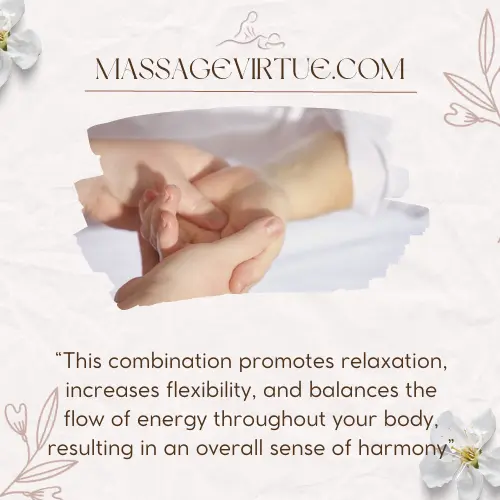
This combination promotes relaxation, increases flexibility, and balances the flow of energy throughout your body, resulting in an overall sense of harmony.
To fully grasp the essence of Thai yoga massage, let’s explore the core principles of this practice in more detail:
The Foundation of Thai Yoga Massage:
At its core, Thai yoga massage is built on several key principles, each contributing to its overall effectiveness:
- Energy Lines (Sen Lines): In Thai medicine, it’s believed that energy flows through the body along specific pathways called Sen lines. These lines are similar to the meridians in Chinese medicine. The practitioner of Thai yoga massage uses thumb pressure and stretching techniques to stimulate and balance the energy flow along these lines, promoting physical and emotional well-being.
- Assisted Yoga Poses: Thai yoga massage involves a wide array of yoga-like stretches and postures. The practitioner gently guides you into these poses, ensuring that they are performed correctly and safely. This aspect of the practice increases flexibility, relieves muscle tension, and enhances overall mobility.
- Acupressure: Acupressure points are a significant component of Thai yoga massage. By applying rhythmic pressure to specific points on the body, the practitioner can help release muscle tension and promote relaxation.
- Breathing: The practitioner encourages deep and mindful breathing throughout the session. Proper breathing enhances relaxation, increases the effectiveness of the stretches, and promotes a meditative state of mind.
- Metta (Loving-kindness): The practice of Metta, or loving-kindness, is an essential element of Thai yoga massage. It involves the therapist maintaining a sense of compassion and care for the client throughout the session. This creates a safe and nurturing environment, fostering trust and relaxation.
Thai yoga massage is a unique blend of these principles, creating a holistic healing experience. It’s not only about physical wellness but also about emotional and energetic balance.
Brief History of Thai Yoga Massage
Understanding the historical roots of Thai yoga massage provides valuable context for appreciating this ancient practice.
Thai yoga massage dates back over two and a half millennia, with its origins attributed to Jivaka Kumar Bhaccha, a physician to the Sangha, the community of Buddhist monks.
The Origins:
The practice is believed to have been developed by Jivaka during the time of Buddha. Jivaka’s healing art was rooted in Ayurvedic medicine, traditional Chinese medicine, and yoga.
Over time, it evolved and absorbed influences from these traditions. The blend of knowledge from these ancient systems gave birth to Thai yoga massage.
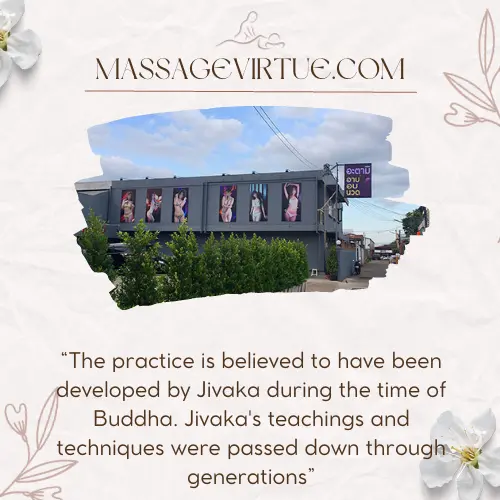
Jivaka’s teachings and techniques were passed down through generations. Thai monks, in particular, played a crucial role in preserving and refining this practice within the walls of monasteries.
For centuries, it was a closely guarded secret, and only select individuals were allowed to learn and practice it.
The Spread to the West:
It wasn’t until the 20th century that Thai yoga massage began to make its way beyond Thailand’s borders. The influence of Westerners traveling to Thailand and discovering this unique form of bodywork led to its introduction in the Western world.
In the mid-20th century, Asokananda, a Thai yoga massage practitioner, and teacher, played a significant role in introducing Thai yoga massage to the West.
His book, “The Art of Traditional Thai Massage,” and his teachings helped pave the way for the practice’s global recognition.
Today, Thai yoga massage is not only practiced in Thailand but has also become a widely sought-after form of therapy around the world, appreciated for its holistic approach to well-being.
About Today’s Thai Yoga Massage
Today, Thai yoga massage has evolved and adapted to suit the needs and preferences of a diverse global audience.
While preserving its core principles, the practice has incorporated modern knowledge of anatomy and physiology, ensuring its relevance and effectiveness in today’s world.
1. Modern Practices:
In contemporary Thai yoga massage, practitioners have gained a deeper understanding of the human body’s anatomy.
This knowledge has allowed for a more precise and effective application of techniques.
Additionally, an emphasis on safety and comfort during sessions has led to the use of comfortable mats, soft padding, and supportive props.
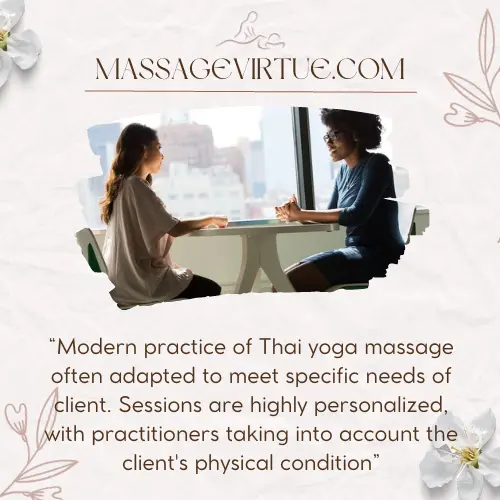
The modern practice of Thai yoga massage is often adapted to meet the specific needs of the client.
Sessions are highly personalized, with practitioners taking into account the client’s physical condition, preferences, and goals.
Whether you’re seeking relief from chronic pain, improved flexibility, or a sense of relaxation and rejuvenation, Thai yoga massage can be tailored to your unique needs.
2. The Cultural Exchange:
The globalization of Thai yoga massage has resulted in a cultural exchange of techniques and practices.
Practitioners and teachers from various parts of the world have contributed to the evolution of the practice.
This cross-cultural pollination has enriched Thai yoga massage with diverse perspectives and approaches.
Today, you can find Thai yoga massage centers and practitioners in almost every corner of the world.
The practice has integrated seamlessly into the broader wellness and complementary therapy landscape.
Benefits of Thai Yoga Massage
One of the most compelling aspects of Thai yoga massage is the myriad of benefits it offers. From physical wellness to mental and emotional balance, this practice has something to offer everyone.
Let’s explore some of the significant advantages of Thai yoga massage:
Physical Benefits:
- Increased Flexibility: Thai yoga massage is renowned for its ability to enhance flexibility. The gentle, assisted stretches and yoga poses employed during sessions gradually improve your range of motion.
- Muscle Tension Relief: The combination of acupressure, stretching, and deep tissue massage techniques effectively relieves muscle tension and soreness.
- Improved Circulation: The practice stimulates blood flow throughout the body, helping to flush out toxins and promote overall wellness.
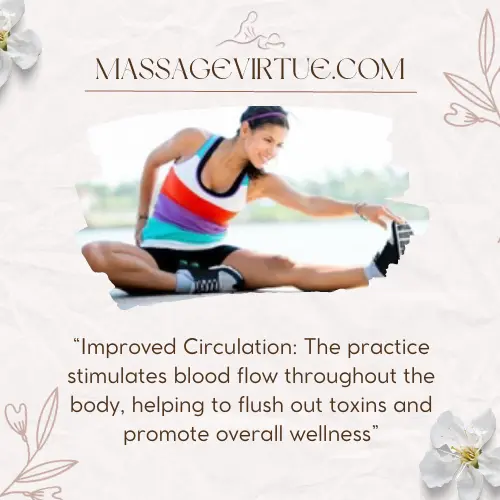
- Pain Relief: Thai yoga massage can be particularly effective for those dealing with chronic pain conditions. It can provide relief from issues like back pain, headaches, and even some musculoskeletal disorders.
- Posture Improvement: Regular Thai yoga massage sessions can lead to better posture and alignment, reducing strain on the body.
Mental and Emotional Benefits:
- Stress Reduction: The soothing nature of Thai yoga massage, combined with mindful breathing, leads to deep relaxation, making it an excellent stress relief technique.
- Enhanced Mental Clarity: Clients often report increased mental clarity and a sense of balance after sessions.
- Improved Sleep: Many individuals experience improved sleep patterns and a greater sense of overall well-being.
- Emotional Release: The practice’s meditative qualities can lead to emotional release and a greater sense of emotional balance.
- Energy Rebalance: Thai yoga massage promotes the balanced flow of energy throughout the body, fostering a sense of vitality and well-being.
What To Expect From Thai Yoga Massage
When you book a Thai yoga massage session, you’re in for a unique and personalized experience. Here’s what you can expect:
The Setting:
Sessions typically take place on a comfortable mat on the floor. Unlike traditional Western massage, you remain fully clothed, which allows for ease of movement during the stretches and poses.
The atmosphere is usually tranquil, and soft music may be played in the background to enhance relaxation.
The Practitioner:
Your practitioner is a skilled and trained individual with a deep understanding of Thai yoga massage techniques. They will guide you through the session, ensuring your safety and comfort throughout.
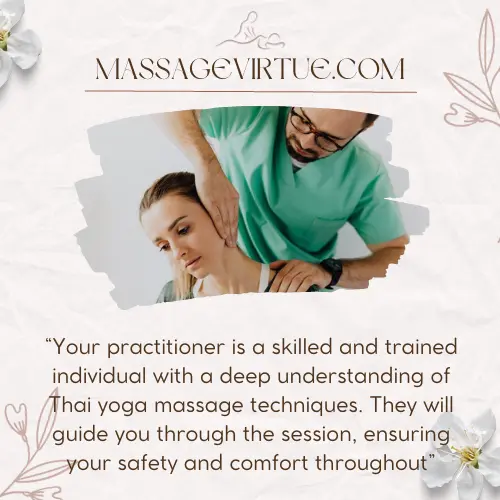
The Experience:
During the session, you can anticipate a combination of gentle stretching, deep tissue massage, and acupressure.
The practitioner will use their hands, feet, elbows, and knees to provide pressure and stretches as needed.
The pressure is applied rhythmically, following the energy lines of the body.
Communication:
Communication is key during a Thai yoga massage session.
It’s important to communicate your preferences, any discomfort, and your goals for the session with the practitioner.
This helps them tailor the experience to your needs.
Benefits During and After the Session:
Throughout the session, you will likely experience a deep sense of relaxation and heightened body awareness.
You may notice increased flexibility and a profound sense of well-being. After the session, it’s common to feel rejuvenated and refreshed.
Preparation:
To prepare for your session, wear comfortable, loose-fitting clothing.
Avoid heavy meals immediately before your appointment, as it’s best to receive a Thai yoga massage on an empty stomach.
Also, consider discussing any specific concerns or areas of focus with your practitioner.
Techniques To Practice Yourself
Thai yoga massage techniques can be adapted for self-practice, allowing you to enjoy the benefits in the comfort of your own home. Here are some techniques you can practice yourself:
Basic Stretches:
- Child’s Pose Stretch: Start in a kneeling position, then lower your buttocks toward your heels, extending your arms forward and resting your forehead on the floor. This stretch is excellent for relaxing the back and shoulders.
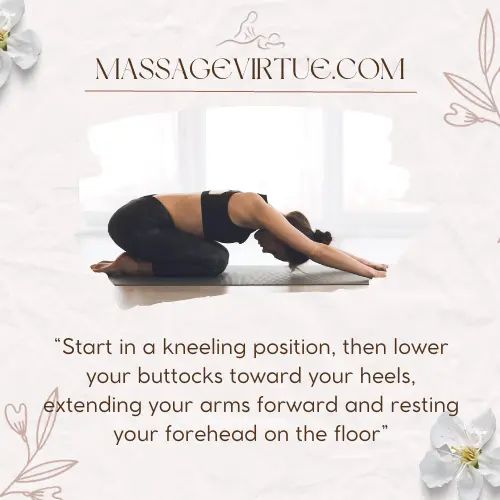
- Seated Forward Bend: Sit with your legs extended in front of you, then bend at the hips to reach for your toes. This stretch helps with hamstring flexibility.
- Chest Opener Stretch: Stand with your feet hip-width apart and interlock your fingers behind your back. Gently straighten your arms and open your chest. This stretch is beneficial for releasing tension in the chest and shoulders.
Self-Massage Techniques:
- Foot Massage: Use a tennis ball or a massage ball to roll under your feet, focusing on areas that feel tense or sore.
- Neck and Shoulder Massage: Gently use your fingers to apply pressure to tight areas in your neck and shoulders. Gradually increase the pressure as your muscles relax.
- Deep Breathing: Practice deep, diaphragmatic breathing to promote relaxation and reduce stress. Inhale deeply through your nose, allowing your abdomen to rise, then exhale slowly through your mouth.
- Mindfulness Meditation: Incorporate mindfulness meditation into your routine to enhance your mental well-being. Focus on your breath, bodily sensations, and the present moment.
By incorporating these self-practice techniques into your daily routine, you can experience the benefits of Thai yoga massage anytime, whether or not you have access to a practitioner.
Conclusion:
Thai yoga massage is a transformative practice that offers a unique blend of ancient wisdom and modern adaptability.
Its rich history, combined with its myriad of contemporary benefits, makes it a valuable tool for improving your physical and mental well-being.
Whether you seek relief from physical ailments, increased flexibility, or simply want to relax and rejuvenate, Thai yoga massage is a holistic approach that caters to your unique needs.
Consider experiencing the harmonious balance it can bring to your life.
In the world of holistic wellness, Thai yoga massage is a shining gem that combines the best of both the ancient and the modern for a healthier, more balanced you.

